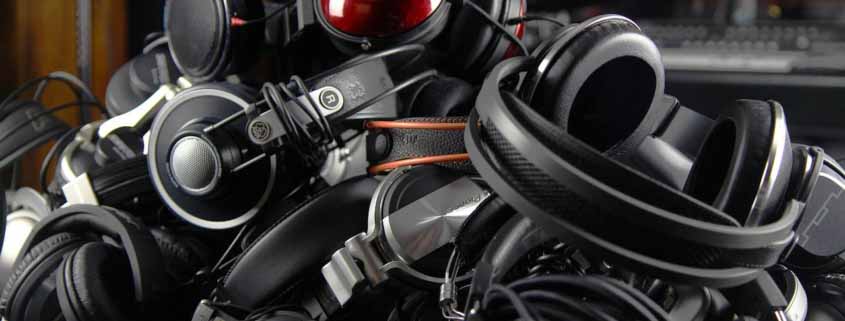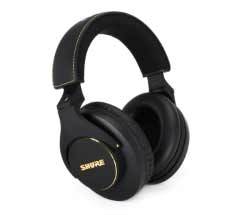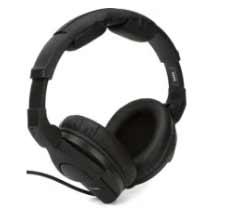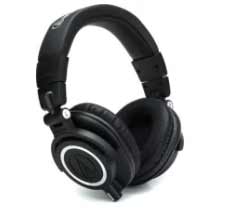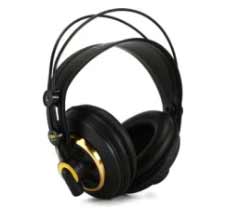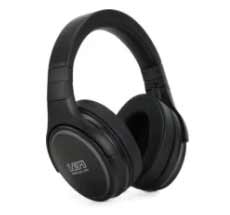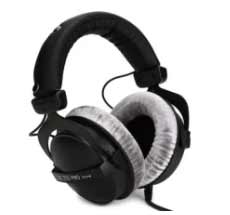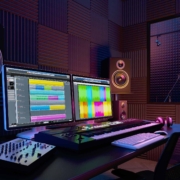Choosing the Best Headphones for Audio Production & Mixing
When it comes to audio production, choosing the best headphones can make all the difference. From capturing every nuance of a recording to achieving a mix that translates well across different playback systems, selecting the right headphones is ideal.
In this section, we will delve into the importance of choosing the right headphones for music production and explore why factors such as sound quality and accuracy are paramount in this decision-making process.
Understanding the Importance of Choosing the Right Headphones for Audio Production
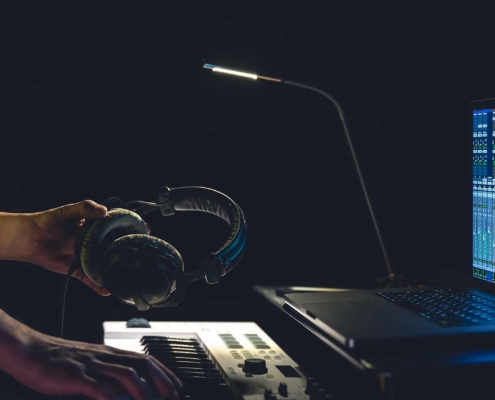
Image by pvproductionson Freepik
Audio production is an intricate art form that requires meticulous attention to detail. Whether you are a professional producer or an aspiring musician working on your latest masterpiece, having headphones that accurately represent the audio spectrum is essential. The right pair of headphones can reveal subtle nuances in your recordings and help you make informed decisions during mixing and mastering.
Sound Quality and Build
One of the key aspects to consider when choosing headphones for music production is sound quality and build. The ability to accurately reproduce every detail of a mix is essential for audio engineers, ensuring that the final product sounds as intended. Additionally, a sturdy build ensures durability and longevity, making sure that your investment in headphones will withstand the demands of daily studio use.
Sound Accuracy and Representation
Accuracy is another crucial factor to consider when selecting headphones for music production. Headphones with a flat frequency response ensure that you hear an uncolored representation of your audio material. This means that there are no enhancements, such as boosted bass, that could alter the original sound.
Sound accuracy enables precise monitoring and ensures that your mixes will translate effectively across different playback systems, including studio monitors and car speakers.
Comfort and Durability

Image by: Freepik.com
During production, you and the artists will be wearing headphones extensively. It is important not to overlook the importance of comfort and durability when making this decision. Spending long hours with uncomfortable or flimsy headphones can hinder productivity and lead to fatigue. Not to mention the wear and tear that the headphones may go through.
Investing in well-built and comfortable headphones not only enhances your listening experience but also contributes to a more productive workflow.
Personal Preference
Another aspect to consider when selecting earphones or headphones for audio production is personal preference.
- How will you use it? Will you be editing and mixing while traveling constantly? Then heavy headphones are probably not the best choice. You want headphones that can be put in your backpack and not take up space.
- Will you wear it for long hours at a time? Select comfortable headphones that are lightweight and not cumbersome.
- Are you editing or mixing? The type of headphones you select can depend on whether you are an audio editor or a mixer. If you are an editor you need detailed headphones that don’t enhance the bass. If you are an audio mixer then you want a full frequency range and solid bass.
- Will you play instruments? If you are a musician, selecting the right earphones or headphones for active playing is important. For example, if you are a drummer, you will likely opt for in-ear earphones for the best isolation and lightweight build.
How do studio headphones differ from consumer headphones?
One of the main differences between studio headphones and consumer headphones lies in their design and construction. Studio headphones are built with durability and long-term use in mind. They often feature sturdy materials, reinforced headbands, and detachable cables for easy replacement if broken.

Images by: Freepik.com
Studio headphones prioritize accuracy and neutrality in sound reproduction. They are specifically engineered to provide an uncolored, flat frequency response across the entire audio spectrum. This means that they faithfully reproduce sound as it was intended by the artist or producer without any added emphasis on certain frequencies.
Consumer headphones tend to enhance specific aspects of the audio experience to cater to different entertainment preferences. Bass-heavy sound signatures or boosted treble are often found in consumer-oriented models to deliver a more enjoyable listening experience for casual users.
Another key difference lies in comfort and fit. Studio headphones are designed for extended periods of use without causing discomfort or fatigue. They typically have larger ear cups with generous padding that provides excellent noise isolation while ensuring a comfortable fit even during long recording or mixing sessions.
Lastly, price plays a significant role in distinguishing studio headphones from consumer ones. Due to their advanced technology and superior build quality, studio-grade headphones tend to be more expensive than their consumer counterparts. However, for professionals who demand uncompromising audio quality and durability, this investment is well worth it.
Key Factors to Consider When Choosing Headphones for Music Production
- Frequency Response: Finding headphones with a wide and accurate flat frequency response.
- Impedance: Understanding how headphone impedance affects sound quality and compatibility with different devices.
- Closed-back vs Open-back: Exploring the pros and cons of closed-back and open-back headphones for music production.
- Noise Isolation: Evaluating the level of noise isolation provided by different headphone models.
- Built-in Features: Considering additional features such as detachable cables, inline controls, and microphone options based on individual needs
Different Types of Headphones and Their Pros and Cons
When it comes to choosing the perfect headphones, understanding the different types available and their pros and cons is essential. With a wide range of options on the market, it can be overwhelming to make a decision. But fear not, as we are here to guide you through the various types of headphones and help you weigh their advantages and disadvantages.
1. Over-ear headphones
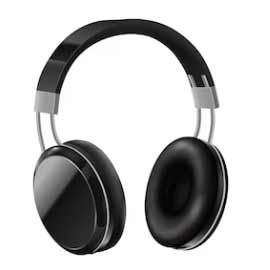
- Pros: These are the classic, large headphones that fully enclose your ears. They offer excellent sound quality and noise isolation, making them ideal for audiophiles or those who want immersive listening experiences.
- Cons: They can be bulky and less portable compared to other types.
2. On-ear headphones
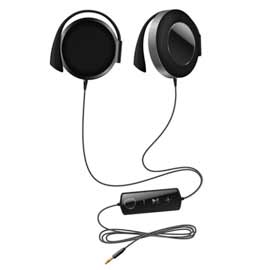
- Pros: These are more compact than over-ear headphones and provide good sound quality while still allowing some ambient noise to pass through. On-ear headphones are a good choice for those who prioritize portability without compromising too much on audio quality.
- Cons: Not ideal for sound isolation or keeping noise out.
3. In-ear and earbuds
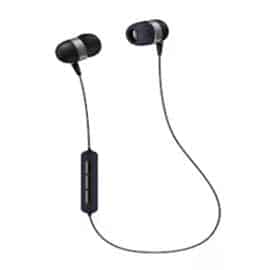
- Pros: Earbuds and in-ear monitors (IEMs) fit snugly near or into your ear canal. They are small, highly portable, and convenient for everyday use. In-ear earphones come in various designs, including wired and wireless options.
- Cons: While they offer decent sound quality and noise isolation, some users may find them uncomfortable during extended wear if not customized to the ear.
4. Wireless Bluetooth
- Pros: These headphones don’t have any wires connecting them together or to a device. True wireless headphones offer ultimate freedom of movement and convenience since there are no cables to tangle or restrict your activities.
- Cons: These types of headphones require batteries and a Bluetooth-compatible device for connection. Similarly, if you engage in audio production for extended periods, the battery is likely to drain quickly. Additionally, Bluetooth introduces some latency in the audio, which may not make it ideal for audio editing, particularly for audio post-production.
5. Noise-canceling headphones
- Pros: This type of headphone actively reduces external noise using advanced technology such as microphones that pick up ambient sounds and produce anti-noise signals. Noise-canceling headphones are excellent for frequent travelers or those working in noisy environments, as they provide a peaceful listening experience.
- Cons: They tend to be more expensive and may affect audio quality slightly. Requires batteries to power the headphones.
Earphones vs Earbuds vs Headphones
While all three options serve the purpose of delivering audio directly into our ears, they each offer unique features that cater to different preferences and lifestyles.
1. Earphones Aka “in-ear”
Let’s start with earphones. These are typically small, lightweight devices that fit snugly inside the ear canal. They provide a comfortable and secure fit, making them perfect for those who are always on the go. Earphones are known for their excellent noise isolation capabilities, ensuring that you can enjoy your favorite music or podcast without any external distractions. Additionally, they often come with built-in microphones and controls for easy hands-free calling and media control.
2. Earbuds
Earbuds, on the other hand, rest just outside the ear canal without fully entering it. They are designed to be compact and portable while maintaining a comfortable fit. Earbuds are popular among fitness enthusiasts as they offer greater freedom of movement during workouts or outdoor activities. However, compared to earphones or headphones, their noise isolation capabilities may not be as effective due to their design.
3. Headphones
Now let’s talk about headphones – the heavyweight champions when it comes to immersive sound quality and comfort. Headphones typically consist of two large speakers that cover your entire ears for a more immersive audio experience.
With larger drivers and better sound insulation from external noise sources, headphones often deliver superior sound quality compared to both earphones and earbuds. They also tend to have longer battery life and additional features like active noise cancellation technology for a truly uninterrupted listening experience.
When it comes to portability, there is a trade-off between size and convenience. Earphones usually win in terms of portability due to their small size; they can easily fit in your pocket or bag. Earbuds follow closely behind, while headphones are bulkier and may require a dedicated storage space. However, advancements in technology have led to the development of foldable and compact headphones that strike a balance between portability and performance.
Ultimately, the choice between earphones, earbuds, or headphones depends on your personal preferences and specific needs. Consider factors such as comfort, sound quality, portability requirements, and budget when making your decision. With the right choice of audio device, you’ll be able to enjoy your favorite music.
Studio Headphones and Digital Technology Converge
The convergence of headphones and digital technology has also expanded the capabilities of music mixing and production. Many studio headphone brands now offer software that allows users to adapt the sound to specific mixing environments, as well as enjoy immersive audio experiences.
With the rising popularity of Dolby Atmos, these headphones play a crucial role in delivering an immersive audio experience. The precise sound reproduction offered by these headphones greatly enhances the overall realism and engagement during the production and mixing process.
What are the top brand studio headphones for audio production and mixing?
When it comes to audio production and mixing, having the right headphones can make all the difference. Whether you’re a professional sound engineer or an aspiring musician, investing in high-quality headphones is essential for achieving accurate and precise audio. Luckily, there are several top brands that have made a name for themselves in this field. From industry-leading technology to exceptional sound quality, these headphone brands have been trusted by professionals worldwide.
How much do studio headphones cost?
While prices can vary greatly depending on factors such as brand, features, and overall sound quality, there are options available to suit every budget. For a beginner looking for an affordable entry-level option, you can expect to spend $99. Anything below it is not recommended for sound quality reasons.
For seasoned professionals seeking top-of-the-line studio headphones, you can expect to spend $200 to $500 depending on the brand and quality.
Conclusion
Choosing the right pair of headphones for music production is vital for achieving professional-grade results. Sound quality and accuracy play pivotal roles in accurately representing your audio material, while comfort and durability contribute to a seamless and enjoyable production process. By understanding the importance of selecting headphones that meet these criteria, you can elevate your music production endeavors to new heights.

